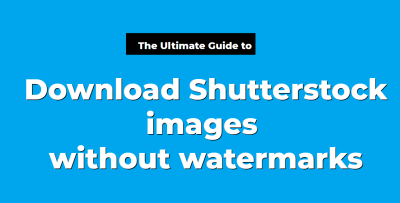If you’ve ever searched for the perfect image to complete your project, chances are you’ve come across Shutterstock. It’s one of the biggest stock photo platforms out there, offering millions of images, videos, and music tracks. But with so many options, understanding how licensing works can be a bit overwhelming. Shutterstock offers various licensing options tailored to different needs, whether you’re creating a blog post, marketing material, or a personal project. Knowing which license suits your use case is key to avoiding legal issues and ensuring you have the right to use the images without hassle.
Understanding One-Time Use Licenses on Shutterstock

When it comes to using Shutterstock images, the term One-Time Use License is an important one to understand. This type of license allows you to use a specific image once, for a designated purpose, and typically for a limited time or reach. It’s perfect for projects with a one-off need, like a single blog post, a social media campaign, or a printed flyer.
Here’s what you need to know about one-time use licenses:
- Single Use: You can use the image only once, for the specific purpose outlined at the time of purchase.
- Limited Distribution: Usually, the license covers a certain number of copies or views, which is specified in the license details.
- Duration: Some licenses are valid for a set period, while others are perpetual but limited to a single project.
- Restrictions: You cannot modify, resell, or redistribute the image beyond your initial use without obtaining additional rights.
Choosing a one-time use license is often the most cost-effective option if you only need the image for a single project or purpose. It’s a straightforward way to legally incorporate high-quality images into your work without committing to a more expensive or extensive licensing agreement.
Always remember to carefully read the license details provided at checkout to ensure the image’s usage aligns with your project’s needs. If you’re unsure about whether a one-time use license covers your intended use, it’s a good idea to contact Shutterstock’s support or review their licensing FAQs. This way, you can confidently use your chosen images, knowing you’re fully compliant with licensing rules.
Step-by-Step Process to Purchase Shutterstock Images for Single Use
So, you’ve decided you want to use a Shutterstock image for a project, but you’re only planning to use it once. No worries! Shutterstock makes it pretty straightforward to purchase images for single use, whether it’s for a blog post, presentation, or social media. Let’s walk through the process step-by-step so you can get your images quickly and hassle-free.
Step 1: Create an Account or Log In
If you don’t already have a Shutterstock account, you’ll need to create one. It’s a simple process—just provide your email, create a password, and fill in some basic info. If you already have an account, just log in to get started.
Step 2: Search for Your Image
Use the search bar at the top to type in keywords related to the image you’re after. You can also filter results by orientation, color, image type, and more to narrow down your options.
Step 3: Preview and Select Your Image
Once you find an image you like, click on it to see a larger preview. Check the details—such as resolution and licensing options—and make sure it fits your needs.
Step 4: Choose the Single-Use License
When you’re ready to purchase, click the “Add to Cart” button. In the checkout window, select the Single Use License. This license allows you to use the image once for a specific purpose, which is perfect for most one-time projects.
Step 5: Review and Checkout
Review your selection, ensure everything looks good, and then proceed to checkout. You can pay with a credit card, PayPal, or other available payment methods.
Step 6: Download Your Image
After completing your purchase, you’ll receive a confirmation email, and your download link will be available in your Shutterstock account. Simply click to download the high-resolution image, and you’re all set to use it in your project.
Pro Tip:
Keep a record of your license purchase and download, especially if you might need to refer back to it later for legal or reference purposes. Shutterstock also provides a license certificate that you can download for your records.
Tips for Selecting the Right Image for Your Needs
Picking the perfect image isn’t always as simple as clicking on the first one that catches your eye. Here are some friendly tips to help you choose images that truly enhance your project and stay within legal bounds.
Understand Your Purpose
First things first—know exactly what you need the image for. Is it for a blog post, a presentation, social media, or a marketing campaign? The purpose will influence the style, composition, and licensing requirements.
Focus on Relevance and Message
Look for images that resonate with your content’s message. For example, if you’re writing about healthy eating, choose images that feature fresh fruits and vegetables rather than generic food shots. An image that aligns with your message makes your content more authentic and engaging.
Consider the Visual Style
- Color Palette: Pick images that match your website or brand colors for a cohesive look.
- Style: Decide whether you want a minimalist, vibrant, professional, or playful style.
- Composition: Look for images with clear focal points that won’t distract from your message.
Check Image Quality and Resolution
Always opt for high-resolution images—at least 1920 pixels wide if you’re using them for print or large displays. Low-resolution images might look pixelated or blurry when scaled up.
Assess Licensing Restrictions
Even for single-use images, pay attention to licensing details. Ensure the image’s license covers your intended use, especially if it’s for commercial purposes. Shutterstock’s single-use licenses are usually flexible, but it’s good to double-check.
Stay Authentic and Original
While stock images are a great resource, try to choose ones that feel authentic and relatable. Avoid overly staged or cliché photos, which can make your project seem impersonal. Sometimes, a simple, genuine image can make a bigger impact.
Test Multiple Options
Don’t settle on your first choice. Download a few options, see how they look in your layout, and decide which one fits best. Sometimes, pairing a couple of images can even tell a better story.
By following these tips, you’ll be well on your way to selecting Shutterstock images that not only look great but also support your project’s goals seamlessly. Happy hunting!
Cost Considerations and Payment Methods
When it comes to purchasing Shutterstock images for one-time use, understanding the costs and available payment options can help you make the best decision for your budget. Shutterstock offers various pricing plans, but if you’re only looking to buy a few images without a subscription, you’ll want to focus on their on-demand packs or single-image licensing.
Pricing Basics: Typically, the cost of a single Shutterstock image for one-time use ranges from $10 to $50, depending on the image resolution and licensing type. High-resolution images or those with extended licenses tend to be pricier. If you need multiple images, buying an image pack can be more cost-effective, as they often come with a discounted rate per image.
Payment Methods: Shutterstock makes it easy to pay using various methods, including:
- Credit or Debit Cards (Visa, MasterCard, American Express)
- PayPal
- Bank Transfers (available in some regions)
- Prepaid Credit Packages (if you plan to buy multiple images over time)
Before making a purchase, double-check if your preferred payment method is accepted in your region. Also, keep an eye out for occasional discounts or promotional offers, especially if you’re buying a handful of images. These can significantly reduce your overall costs.
Remember, it’s important to choose the licensing option that fits your needs. For one-time use, a standard license usually suffices. However, if you plan to use the image in a large commercial campaign or a product for resale, an extended license might be worth the extra investment.
How to Download and Use Shutterstock Images Legally
Once you’ve selected and purchased your Shutterstock image, the next step is downloading it and ensuring you’re using it legally. It’s pretty straightforward, but a few key points are worth noting to stay compliant with licensing rules.
Downloading Your Image: After completing your purchase, you’ll be directed to a download page where you can select the image resolution you need. For most online uses, a standard resolution suffices, but if you plan to print in large formats, opt for the high-resolution version. Simply click the download button, and the image will be saved to your device.
Using Shutterstock Images Legally: Here’s what you need to keep in mind:
- Adhere to the License Terms: The standard license typically allows for use in digital ads, websites, social media, presentations, and print materials up to a certain print run. Always review the license details for restrictions.
- No Reselling or Redistribution: You can’t resell the image as a standalone product or redistribute it in bulk, such as in stock image collections.
- Respect Model and Property Releases: If the image features recognizable people or private property, ensure it includes the necessary releases for commercial use.
- Avoid Modifying in Restricted Ways: Some licenses restrict significant modifications, especially if they could portray individuals negatively or infringe on rights.
In practice, using Shutterstock images legally means respecting the license terms, giving proper attribution if required (though Shutterstock images generally do not require attribution), and not using the images in a way that could harm or infringe on someone’s rights.
If you’re unsure about any licensing aspect, Shutterstock provides detailed licensing guides and customer support to help clarify your rights. When in doubt, it’s always better to double-check before publishing or distributing your content. This way, you stay on the right side of legal use and avoid potential copyright issues down the line.
Common Mistakes to Avoid When Buying Shutterstock Images
Buying images for a project might seem straightforward, but there are a few common pitfalls that can trip you up if you’re not careful. Let’s go over some of the biggest mistakes to watch out for when purchasing Shutterstock images for one-time use, so you can save yourself time, money, and potential legal headaches.
Not Checking the License Details
One of the most frequent mistakes is not thoroughly reading the licensing terms. Shutterstock offers different license types, and it’s crucial to ensure that the image license covers your intended use. For example, a standard license might limit the number of copies or restrict usage in certain contexts, while an extended license can provide broader rights. Skipping this step can lead to unintentional misuse and copyright issues down the line.
Ignoring Image Quality and Resolution
Another common error is selecting images without paying attention to resolution and quality. Always double-check that the image resolution meets your needs—especially if you plan to print or display the image on large screens. Using a low-resolution image for a large banner, for example, can result in a pixelated, unprofessional look.
Overlooking the Relevance and Uniqueness
Sometimes, buyers choose images that are popular or overused, which can make your project look generic. Take the time to find unique and relevant images that truly match your message and brand personality. Using overly generic stock photos can diminish the authenticity of your content.
Not Considering the Image’s Composition and Context
Misunderstanding the context or the composition of an image can cause issues. For instance, an image with people in it might have model releases or rights that restrict commercial use. Also, ensure the image’s composition aligns with your content’s tone and layout, so it integrates seamlessly.
Failing to Save and Organize Purchased Images
Finally, don’t forget to keep a record of your purchased images and their licenses. Losing track can lead to accidental reuse or difficulty proving you have the right to use an image, especially if disputes arise. Create a dedicated folder or database for your licensed images for easy access and future reference.
Alternatives to Shutterstock for One-Time Image Purchases
While Shutterstock is a popular choice, it’s not the only game in town. There are several other platforms where you can find high-quality images suitable for one-time purchases. Exploring these options can help you find the perfect image at a better price or with different licensing options that suit your project.
1. Adobe Stock
Adobe Stock offers a vast library of images, illustrations, videos, and templates. Its licensing options are flexible, and if you’re already using Adobe Creative Cloud apps, you can easily license and access images directly within programs like Photoshop or Illustrator. They offer both subscription plans and single image purchases, making it convenient for one-off needs.
2. iStock by Getty Images
iStock provides high-quality images with a focus on affordability. They have a wide range of images available for single purchase, often at lower prices than Getty’s main site. Their flexible licensing options make it a good alternative for one-time projects.
3. Pixabay and Unsplash (Free Options)
If you’re on a tight budget, websites like Pixabay and Unsplash offer free images that are royalty-free and can be used for commercial purposes. Just be sure to check the licensing details, as some images may have restrictions or require attribution.
4. Depositphotos
Depositphotos offers a large collection of stock images with flexible licensing options. You can purchase images on a pay-per-download basis, making it a good choice for one-time use without committing to a subscription.
5. Stocksy
Stocksy specializes in high-quality, artistic images with a unique style. They offer single image licenses, and their images are often more exclusive, helping your project stand out.
Summary Table of Alternatives
| Platform | Pricing Model | Unique Features |
|---|---|---|
| Adobe Stock | Subscription & Single Purchase | Integrates with Adobe apps, vast library |
| iStock | Pay-per-image | Affordable, high-quality images |
| Pixabay & Unsplash | Free | Royalty-free, no cost, wide variety |
| Depositphotos | Pay-per-download | Large library, flexible licensing |
| Stocksy | Single & subscription | Artistic, exclusive images |
Choosing the right platform depends on your specific needs, budget, and the style of images you’re after. Remember, always review licensing terms carefully, regardless of where you buy, to ensure your project remains compliant. Exploring these alternatives can diversify your options and help you find the perfect image for your one-time use project.
Final Tips for Managing Your Image Licensing Rights
Securing the right license for your Shutterstock images is crucial to avoid legal complications and ensure proper usage. Here are some essential tips to help you effectively manage your image licensing rights:
- Understand the License Types: Shutterstock offers different licenses, including Standard and Enhanced. Make sure you choose the one that fits your project needs, whether for web, print, or commercial use.
- Keep Documentation: Save all licensing agreements, receipts, and image files. Having a well-organized record helps you verify your rights if questions arise later.
- Review Usage Restrictions: Pay close attention to restrictions such as the number of copies, geographic limits, or the type of media where the image can be used. Violating these can lead to legal issues.
- Monitor Your Usage: Regularly review where and how your images are used to ensure compliance with licensing terms, especially if your project expands or changes scope.
- Be Cautious with Resale or Redistribution: Generally, you cannot resell or redistribute Shutterstock images without proper licensing. Respect these boundaries to maintain legal integrity.
| Tip | Why It Matters |
|---|---|
| Keep Records | Ensures proof of licensing rights and helps resolve disputes. |
| Understand Restrictions | Avoids unintentional violations that could lead to legal action. |
| Regular Monitoring | Ensures ongoing compliance as your usage evolves. |
By following these tips, you can confidently manage your Shutterstock image licenses, protecting your projects and maintaining legal peace of mind. Proper licensing management is an ongoing process that safeguards your creative work and ensures ethical use of licensed images.


